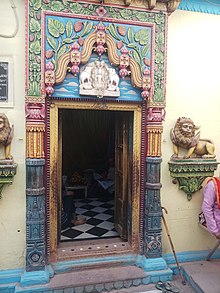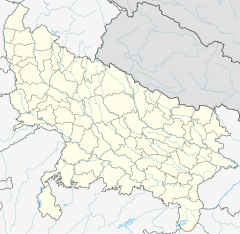| Vishalakshi Temple | |
|---|---|
 Entrance to the temple Entrance to the temple | |
| Religion | |
| Affiliation | Hinduism |
| District | Varanasi |
| Deity | Visalakshi |
| Location | |
| Location | Mir Ghat, Varanasi |
| State | Uttar Pradesh |
| Country | India |
 | |
| Geographic coordinates | 25°18′32″N 83°0′39″E / 25.30889°N 83.01083°E / 25.30889; 83.01083 |
| Architecture | |
| Type | Mandir |
| Creator | Nagarathar |
| Completed | 1893 |
| Inscriptions | In Tamil |
The Vishalakshi Temple, also known as Vishalakshi Gauri Mandir and Vishalakshi Amman Kovil. It is one of the famous Hindu temple at Varanasi. Dedicated to the goddess Vishalakshi (an aspect of the goddess Parvati). It was Built and Maintained by Nattukottai Nagarathar a mercantile community from Tamil Nadu
It is generally regarded as a Shakti Pitha, the most sacred temples dedicated to the Hindu Divine Mother. The earrings of the goddess Sati were said to have fallen on this holy spot of Varanasi. Vishalakshi Temple is known for its temple festival on Kajali Tij, held on the third day during waning fortnight in the Hindu month of Bhadrapada (August).
Location
Vishalakshi Temple is situated near Mir Ghat, Varanasi. It is situated 250 metres (0.16 mi) north west of the Kashi Vishwanath Temple and 200 metres (0.12 mi) of Annapurna Temple.
Religious significance
The name Vishalakshi (Viśālākshī, Sanskrit: विशालाक्षी, "she who has large eyes") is an epithet of the goddess Parvati. Parvati is described as Vishalakshi in the scripture Shiva Purana, when her future husband Shiva sees her for the first time.
Annapurna, the goddess of food and a form of Parvati, is given the epithet Vishalakshi, the "wide-eyed". Her most famous temple stands at Varanasi, where patron goddess she is considered. The Skanda Purana narrates the tale of the sage Vyasa cursing Varanasi, as no one in the city offered him food. Finally, Vishalakshi appears in the form of a housewife and grants food to Vyasa. This role of Vishalakshi is similar to that of Annapurna, who offers food to her husband Shiva, whose hunger can be satiated by her food. Shiva gratified by Annapurna's food, establishes Varanasi and appoints her as its presiding goddess. The goddess Vishalakshi of the Varanasi temple may have been identified with Annapurna in early times, however over time became a distinct goddess, resulting in the two separate goddess temples.
In the Kashi Khanda of the Skanda Purana, Vishalakshi accompanies Vishwanath (a form of Shiva venerated in Kashi Vishwanath Temple) to grant a boon to the god Kubera. Another chapter from Kashi Khanda also offers her exultation.
In the sacred geography of Varanasi, six points are said to symbolize Shastanga (six-fold) yoga, which is performing by visiting the six sites. They are the Vishwanath Temple (the most important temple of Varanasi - dedicated to Shiva), the Vishalakshi Temple, the Ganges, the Kala Bhairava temple (dedicated to Varanasi's guardian deity and Vishalakshi's Bhiarava), the Dhundiraj Temple (dedicated to the god Ganesha - son of Shiva and Parvati) and the Dandapani temple (dedicated to an aspect of Shiva).
Shakti Pitha
Vishalakshi (Sanskrit: विशालाक्षी) or Varanasi figures in most standard lists of Shakti Pithas.

The daughter of Prajapati Daksha, Sati was married to the god Shiva against his wishes. Daksha organized a great yajna, but did not invite Sati and Shiva. Uninvited, Sati reached the yajna-site, where Daksha ignored Sati and vilified Shiva. Unable to withstand this insult, Sati jumped into the sacrificial fire and committed suicide. Sati died, but her corpse did not burn. Shiva (as Virabhadra) slew Daksha for being responsible for Sati's death and forgave him, resurrecting him. The wild, grief-stricken Shiva wandered the universe with Sati's corpse. Finally, the god Vishnu dismembered the body of Sati into 51 parts, each of which became a Shakti Pitha, temple to a form of the Goddess. Shiva is also worshipped at each Shakti Pitha in the form of Bhairava, the male counterpart or guardian of the presiding goddess of the Pitha. Sati's eye or earring is believed to have fallen at Varanasi, establishing Vishalakshi as a Shakti Pitha.
The Tantric work Rudrayamala, composed before 1052 CE, mentions 10 principal Shakti Pithas, which includes Varanasi as the fifth one. The Kularnava Tantra mentions 18 Pithas and mentions Varanasi as the sixth one. The Ashadashapitha (18 Pithas) ascribed to Shankaracharya (interpreted as Adi Shankara, however probably Shankara Agamacharya, Bengali author of the Tara-rahasya-vrittika) enumerates 18 names along with their presiding deities or Pitha-devis including Vishalakshi of Varanasi as the fifth Pitha. In the Kubjika Tantra, Varanasi is third in 42 names. There are the two lists of Pithas in the Jnanarnava, one with 8 names and the other with fifty names. The 8-name list does not mention Varanasi, but the other list names Varanasi in the second spot. Vishalakshi of Varanasi is mentioned as first of 108 Shakti Pithas in the list in the Devi Bhagavata Purana. The face of Sati is described to have fallen here. This is the only instance where a body part is related to the Shakti Pitha in the text. The Devi Gita within the same text gives a long list of Pithas, where Vishalakshi is mentioned as dwelling in Avimukta (Varanasi). No body part is related to the Pitha in this list. In the non-scripture 16th century Bengali work Chandimangal, Mukundaram lists nine Pithas in the Daksha-yajna-bhanga section. Varanasi is the last Pitha described to be the place where Sati's chest fell and the presiding goddess being Vishalakshi. Lakshmidhara also includes Vishalakshi in his 12th-century list.
The Pithanirnaya or Mahapithanirupana section from the Tantrachudamani originally listed 43 names, but names were added over time making it 51 Pithas. It details the Pitha-devata or Devi (name of goddess at the Pitha), the Kshastradishas (Bhairava, consort of the goddess) and the anga-pratyanga (limbs including ornaments of Sati). Manikarnika at Varanasi with Vishalakshi as the presiding goddess comes in at number 23. A kundala (earring) is the anga-pratyanga and Kala-Bhairava (Kala) is the consort. In some later versions of the text, Varanasi is not included in the chief 51/52 Pithas. In one of the versions, it is demoted from a Pitha to an upa-Pitha (subordinate Pitha). Here, the kundala is said to be anga-pratyanga, but two Pitha-devatas and Bhairavas are mentioned. First, Vishalakshi with Kala-Bhairava and secondary Annapurna with Vishweshvara. Vishweshvara is the presiding deity of Kashi Vishwanath Temple, the most important temple in Varanasi and the Annapurna temple is nearby.
Tamil Associations

Vishalakshi, the "wide-eyed" goddess is often associated two other goddesses: Kamakshi, the "love-eyed" goddess of Kanchipuram and Minakshi, the "fish-eyed" of Madurai, prominently because of their similar names. Together the three are regarded the most important Goddess temples by Tamil People. While Vishalakshi dwells in North India, the other goddess temples are in Tamil Nadu, South India. Tamil People venerated Vishalakshi for ages and have strong ties with the temple.

The current structure of the temple was built in 1893 by Nattukottai Nagarathar, a Mercantile community from Tamil Nadu
Worship and festivals
Devotees often bathe in the holy Ganges nearby before offering worship at the temple. The puja (worship), offerings, recitation of hymns to the goddess and charity at the temple is considered highly fruitful because of the power of the presiding goddess. The goddess is especially worshipped by unmarried girls for a groom, childless couples for progeny and unfortunate women for the turn of their fortune. Two goddess images are housed side by side in the garbhagirha (sanctum): a smaller black stone image called Adi Vishalakshi on left back side and another taller black stone image installed at a later date. Devotees often visit the Vishwanath and Annapurna shrines with this temple.
Two most important festivals in the temple, as well as all other goddess temples in Varanasi, is two Navaratris ("nine nights"). The Ashwin Navatri or simply called Navaratri, culminating in Vijayadashami, falls in the waxing fortnight of the Hindu month of Ashwin (October) and celebrates the victory of the goddess Durga on the buffalo-demon Mahishasura. The other Navaratri is in the waxing fortnight of Chaitra (March). On each of nine days, one of Varanasi's goddess temples – corresponding to one of the Navadurga (nine Durgas) or nine Gauris (Parvatis) – is recommended to be visited. The nine-temple circuit is described in various Kashi mahatmyas (texts narrating the greatness of the holy city of Varanasi/Kashi). Devotees flock to the temple in the evening of the fifth day of Navatri.
The yearly temple festival of Vishalakshi Temple is celebrated on Kajali Tij (Black Third), the third lunar day (tij) of the waning fortnight in Bhadrapada, the last month of the Indian rainy season. Women sing "amorous" rainy season songs called kajali (black) around this time. The holy day is observed especially for the welfare of brothers by women.
See also
Notes
- Eck 1982, p. 229.
- சோமலெ (1963). ஸ்ரீ காசி நாட்டுக்கோட்டை நகரச்சத்திர நூற்றாண்டு மலர் [Sri Kashi Nattukottai Naga Chatra Centennial Issue] (in Tamil). Karaikudi,Tamilnadu. p. 33.
{{cite book}}: CS1 maint: location missing publisher (link) - Bangala Bhasar Abhidhaan ( Dictioanary of the Bengali Language), Shishu Sahitya Samsad Pvt Ltd., 32A, APC Road, Kolkata – 700009, Volume 2, p.1600. (ed. 1988)
- www.wisdomlib.org (6 October 2018). "Śiva-Himavat dialogue [Chapter 12]". www.wisdomlib.org. Retrieved 2 October 2022.
- ^ P. Arundhati (1 January 2001). Annapurna: A Bunch of Flowers of Indian Culture. Concept Publishing Company. pp. 17–21. ISBN 978-81-7022-897-4. Retrieved 19 November 2012.
- www.wisdomlib.org (8 September 2020). "Gandhavatī and Alakā [Chapter 13]". www.wisdomlib.org. Retrieved 28 November 2022.
- www.wisdomlib.org (10 September 2020). "Establishment of the Deities [Chapter 70]". www.wisdomlib.org. Retrieved 6 February 2023.
- Eck 1982, p. 323.
- ^ Eck 1982, p. 172.
- Eck 1982, p. 173.
- Sircar 1998, pp. 17–20.
- Sircar 1998, pp. 25–7.
- Swami Satyananda (1 July 1996). Devi Gita. Devi Mandir. pp. 52, 192. ISBN 978-1-877795-13-8. Retrieved 19 November 2012.
- C MacKenzie Brown (1998). The Devī Gītā: The Song of the Goddess. SUNY Press. pp. 242–6. ISBN 978-0-7914-3940-1. Retrieved 19 November 2012.
- Sircar 1998, pp. 32–3.
- Sircar 1998, pp. 35–41.
- V. K. Subramanian (1 January 2003). Art Shrines Of Ancient India. Abhinav Publications. p. 30. ISBN 978-81-7017-431-8. Retrieved 20 November 2012.
- பழ.கைலாஷ், (Kailash PL). தமிழ் அண்ணை விசாலாட்சி (in Tamil) (OreNadu - November 2022 ed.). ஒரே நாடு. p. 23.
- ^ Varanasi Temples
- Eck 1982, p. 174.
- Eck 1982, p. 263.
- Eck 1982, p. 266.
References
- Jones, Constance; Ryan, James D. (2007). Encyclopedia of Hinduism. Infobase Publishing. pp. 401–402. ISBN 9780816075645. Retrieved 14 November 2012.
- Sircar, Dines Chandra (1998). The Śākta Pīṭhas. Motilal Banarsidass Publ. pp. 4–6, 12.13 & 24–26. ISBN 9788120808799. Retrieved 14 November 2012.
- Eck, Diana L. (1982). Banaras: City of Light. Motilal Banarsidass Publ. pp. 239, 242, 365. ISBN 9788120808799. Retrieved 14 November 2012.
- Vanamali, Diana L. (2008). Shakti: Realm of the Divine Mother. Inner Traditions / Bear & Co. pp. Review page. ISBN 9781594771996. Retrieved 14 November 2012.
- Bartaman, a Bengali magazine Sharad Sankhya 1410 (Bengali year) - details mentioned in the article Kashir Vishwanath Vishwanather Kashi by Suman Gupta at page 60.
| Shaktism | ||
|---|---|---|
| Devi |  | |
| Matrikas | ||
| Mahavidya | ||
| Navadurga | ||
| Shakta pithas | ||
| Texts | ||
| Regional variations | ||